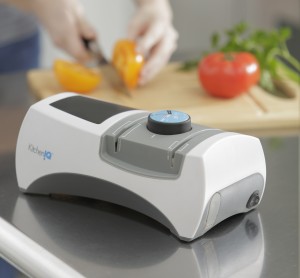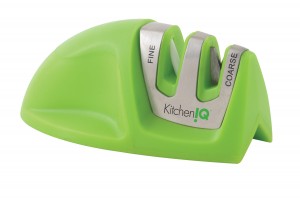Knife Sharpeners Complete Cutlery Purchases
For many customers knife sharpening can be an intimidating task. However, occasional sharpening is essential to properly maintaining a blade for optimal use and ultimately expanding the lifespan of a knife. This is an area where customers can use some extra help to feel comfortable completing the job on their own.
The first question a home cook may have about knife sharpening is, when is it time to sharpen a knife? A quick test to answer this question is to try to slice a tomato. If the knife slips and slides, or if you have to apply a lot of pressure, it is time to sharpen the knife.
“Home cooks should never let their knife go dull, so that means you should sharpen your knives regularly. A safe knife is a sharp knife,” says Melissa Moore, Housewares Marketing Manager for Smith’s Consumer Products, parent company of KitchenIQ, which specializes in knife sharpeners for the independent retail market. “You’re really going to tell when to sharpen by the function of the knife, because it could look really sharp to you and it might even feel sharp on your finger, but really it’s not sharp enough. You sharpen all the way from the heel to the tip so you might have sharp areas but it might not be the full knife that is sharp.”
Sharp knives are safest because the cutting task can be completed with ease, whereas a dull knife might cause the user to struggle and accidentally cut themselves. If a cut does occur, a cut from a sharp knife will be cleaner than one from a dull knife, and will heal better.
How often a knife needs to be sharpened depends on how often it is used. A home cook using a knife regularly probably only needs to sharpen it every couple of weeks. If it is a knife that is used a few times a year, then only sharpen it once a year. How frequently a knife needs to be sharpened also depends on the quality of the knife. Sturdier knives will not require as much sharpening as a knife with a type of metal that easily dulls.
“You really don’t want to sharpen every time you use it, because every time you sharpen you remove metal,” says Moore. “Some knives are extremely expensive, so you don’t want to continually sharpen. You just want to clean that edge and realign, and then sharpen as you need to.”
Edges can be realigned by using a steel rod. It is important to distinguish that steel rods do not actually sharpen knives, but rather realign curved edges. Every time a knife is used, the edge rolls slightly under. A steel rod straightens it out again, and it is fine to realign the edge before each use since it does not remove metal like sharpening does. There are some rods, such as Hewlett Manufacturing’s JewelStik, that have diamond or ceramic abrasives and those sharpen as well as realign, notes Moore.
Knife sharpeners fall under several categories. There are electric models, manual or pull-through varieties and sharpening stones. A single stage pull-through knife sharpener would be a good option for a person just beginning to sharpen their own knives. This type will have a fixed angle to take the guesswork out of holding the knife correctly. Higher end versions of the pull through sharpener might have two stages with both a coarse and fine option. Others might also offer the ability to sharpen knives with with varying edge angles on a single unit.
Electric sharpeners can speed up the sharpening process for home cooks who have a large collection of knives. As with the manual models, the more options the sharpener has, the more of an investment it will require. Abrasives on all sharpeners can range from synthetics, ceramics, and diamonds. Diamond abrasives are more aggressive and are typically found in the coarse slot for really restoring the edge of a dull knife. Ceramics are less aggressive and are used in the fine slot for finishing. Higher end electric sharpeners will have both types of abrasives to encompass a full set of options for the user. A premium sharpener should also typically include the option of sharpening various blade angles and sharpening both sides of the knife at the same time.
“If you have a large block of knives, it makes sense to invest in an electric sharpener so you’re not spending so much time sharpening,” says Moore. “If you just have a few knives at home, then a manual sharpener makes sense … An electric sharpener can sometimes be an investment as well. If you make an investment in a premium quality set of knives, then you probably want to invest in a premium sharpener as well.”
Sharpening on a stone is a skill that takes practice to master and is not typically recommended for entry level use. It requires knowledge of the proper angle to hold the knife at, as well as technique to pull the knife across the stone correctly. Although it may seem counter-intuitive, a sharpening stone is actually the most advanced method of sharpening, skill-wise.
“It’s important that retailers realize that as much attention as they give to cutlery in their stores, it’s important to offer the option of maintaining that cutlery,” say Moore. “It doesn’t matter what price point they’re carrying in cutlery, they need to offer an option for a consumer to maintain that cutlery at home. Often we say, have one to show and one to go … it’s important for consumers to feel and touch things. Retailers could have something out for customers, have them be able to look at the electric sharpeners and see the difference between different versions that are out there … Give the whole story on how to take care of a knife, from maintaining it to storage.”
This story was originally published in the June 2015 issue of Kitchenware News, a publication of Oser Communications Group.



You must be logged in to post a comment.